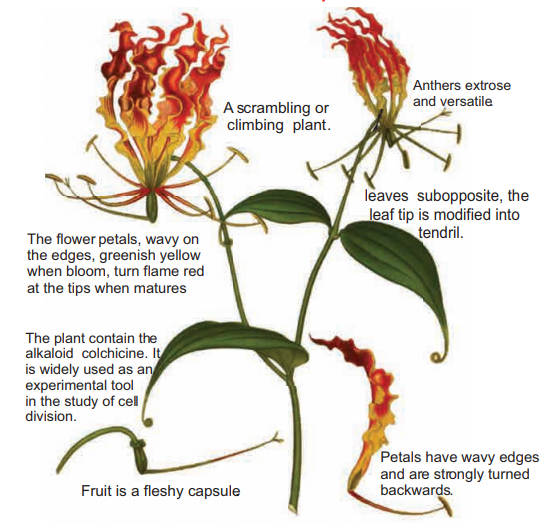Botany - Summary - Taxonomy and Systematic Botany | 11th Botany : Chapter 5 : Taxonomy and Systematic Botany
Chapter: 11th Botany : Chapter 5 : Taxonomy and Systematic Botany
Summary - Taxonomy and Systematic Botany
State Flower of Tamil Nadu : Gloriosa superba

The name of Gloriosa superba is composed of two greek words Gloriosa means full of glor
y, superba means superb.
This plant was placed earlier in Liliaceae.
Summary
Taxonomy deals with the identification, naming and
classification of plants. But systematics deals with evolutionary relationship
between the organisms in addition to taxonomy. Taxonomic hierarchy was
introduced by Carolus Linnaeus. It also includes ranks. Species is the
fundamental unit of taxonomic classification. Species concept can be classified
into two groups based on the process of evolution and product of evolution.
There are three types of species, morphological, biological and phylogenetic
species. Type concept emphasizes that a specimen must be associated with the
scientific name which is known as nomenclatural type. There are different types
and they are holotype, isotype, lectotype etc. Taxonomic aids are the tools for
the taxonomic study such as keys, flora, revisions, catalogues, botanical
gardens and herbaria. Botanical gardens serve different purposes. They have
aesthetic value, offers scope for botanical research, conservation of rare
species and propagation of many species. Botanical survey of India explores and
documents biodiversity all over India. It has 11 regional centres in India.
Herbarium preparation includes plant collection, documentation of field data,
preparation of plant specimens, mounting and labelling. There are several
national and international herbaria. National herbaria include MH, PCM, CAL
etc. Kew herbarium is the world’s largest one.
Classification is the basis for cataloguing and
retrieving information about the tremendous diversity of flora. It helps us to
know about different varieties, their phylogenetic relationship and exact
position. Some important systems of classification are fall in to three types;
artificial, natural and phylogenetic. Carolus Linnaeus outlined an artificial
system of classification in “Species Plantarum” in 1753. The first scheme of classification based on overall
similarities was presented by Antoine Laurent De Jessieu in 1789. A widely followed
natural system of classification was proposed by George Bentham (1800 - 1884)
and Joseph Dalton Hooker. This system was not intended to be phylogenetic. One
of the earliest phylogenetic systems of classification was jointly proposed by
Adolf Engler and Karl A Prantl in a monumental work “Die Naturelichen Pflanzen
Familien”. Arthur Cronquist proposed phylogenetic classification of
flowering plants based on a wide range of taxonomic characters including
anatomical and phytochemical of phylogenetic importance in his book titled “The
evolution and classification of flowering plants.”Angiosperm phylogeny group
(APG) classification is the most recent classification of flowering plants
based on phylogenetic data. APG system is an evolving and currently accepted
system across the world and followed by all the leading taxonomic institutions
and practising taxonomists.
Cladistics is the methodology, used to classify
organisms into monophyletic groups, consisting of all the descents of the
common ancestors. The outcome of a cladistic analysis is a cladogram and is
constructed to represent the best hypothesis of phylogenetic relationships.
Chemotaxonomy is the scientific approach of classification of plants on the
basis of their biochemical constituents in them. Utilization of the characters
of chromosome for the taxonomic inference is known as karyotaxonomy. The
application of serology in solving taxonomic problems is called serotaxonomy.
Molecular Taxonomy is the branch of phylogeny that analyses hereditary molecular
differences, mainly in DNA nuclear and chloroplast sequences, to gain
information and to establish genetic relationship between the members of
different taxonomic categories. Different molecular markers like allozymes,
mitochondrial DNA, microsatellites, RAPDs, AFLPs, single nucleotide
polymorphism- SNP, microchips or arrays are used in analysis. Molecular
Taxonomy unlocks the treasure chest of information on evolutionary history of
organisms.It plays a vital role in phytogeography, which ultimately helps in
genome mapping and biodiversity conservation. DNA barcoding is a taxonomic
method that uses a very short genetic sequence from a standard part of a
genome. It helps in identification of organisms.
Related Topics